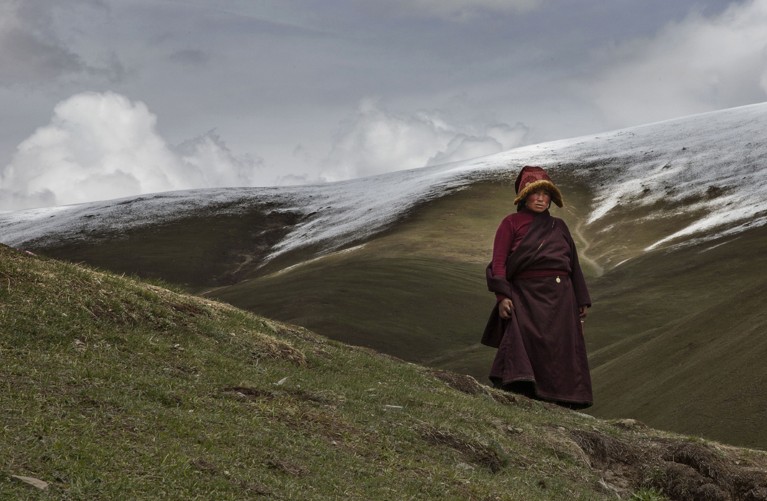Dyani Lewis

Modern inhabitants of the Tibetan Plateau are descendants of people who have occupied the ‘roof of the world’ for the past five millennia. In the biggest study of its kind, researchers sequenced dozens of ancient genomes from the region, revealing where its ancient settlers came from and how they adapted to high-altitude living1.
The Tibetan Plateau extends from the northern edge of the Himalayas across 2.5 million square kilometres. It is a high-altitude, dry and cold region. Despite its inhospitable environment, humans have been present on the plateau since prehistoric times. Denisovans, extinct hominins that interbred with both Neanderthals and the ancestors of modern humans, lived on the northeastern edge of the plateau 160,000 years ago. Stone tools made 30,000–40,000 years ago are further signs of an early human presence in the region2.
But when people established a permanent presence on the plateau — and where they came from — has been a matter of debate, says Qiaomei Fu, an evolutionary geneticist at the Chinese Academy of Sciences in Beijing, who led the study.
Historical records date back only 2,500 years. Dating of sediments with human hand- and footprints in the central plateau indicated that people might have lived there permanently as long as 7,400 years ago3.
Fu and her team sequenced ancient genomes from the remains of 89 individuals, dated to 5,100–100 years ago, unearthed from 29 archaeological sites. Their study confirms that permanent occupation of the region pre-dates historical records. It also paints a complex picture of where early Tibetans migrated from, and how their interactions in the region and with their lowland neighbours shaped their heritage.
“It’s very exciting that we are getting ancient DNA from this geographical region,” says Vagheesh Narasimhan, a computational genomics researcher at the University of Texas at Austin.
Eastern origins
Analysis of the genomes reveals that the ancient occupants of the Tibetan Plateau have strong genetic links to the Tibetan, Sherpa and Qiang ethnic groups that live on or near the plateau today. Comparisons of the oldest genomes with ancient and living people across Asia suggest that the ancestors of modern Tibetans arrived on the plateau from the east. By contrast, India and the rest of the Asian subcontinent were populated by immigrants from eastern Eurasia and central Asia4.
“They were definitely East Asian, and they were northern East Asian,” says Fu. The genomes reveal fresh influxes of genes that suggest lowland East Asian immigrants arrived on the plateau more than once. Trade with millet farmers from the upper Yellow River region of what is now northeastern China was probably responsible for interactions between existing Tibetan settlers and newcomers before 4,700 years ago. During the past 700 years, there has been a further influx of genes from the east.
“There’s a continuity,” says Irene Gallego Romero, a genomics researcher at the University of Melbourne in Australia, “but there is also consistent movement of influences in and out of the region.”
Evidence of these interactions has existed in the form of pottery and other artefacts, but this is the first definitive sign that populations were exchanging more than their culture and knowledge, says Fu.
Living the high life
The genomes also reveal how Tibetan settlers adapted to their environment. Many present-day inhabitants of the Tibetan Plateau have a version of a gene, EPAS1, that allows them to thrive in the lower-oxygen environment5. The high-altitude variant of EPAS1 is thought to have originated from Denisovans.
Fu and her team were able to track the increasing prevalence of the high-altitude EPAS1 variant over time. Whereas just over one-third of the studied individuals dated to before 2,500 years ago had the variant, nearly 60% of those dated to between 1,600 and 700 years ago had the gene. That’s still lower than the 86% incidence in present-day Tibetans, suggesting that there’s been rapid selection for this variant in recent prehistory. “It’s a poster child for natural selection in humans in recent times,” says Narasimhan.
It’s still unclear when the high-altitude EPAS1 variant first appeared. “It would be really interesting to know how far back that goes,” says Gallego Romero. Fu is keen to answer this question by sequencing genomes of older remains, if they are discovered on the plateau.
No comments:
Post a Comment